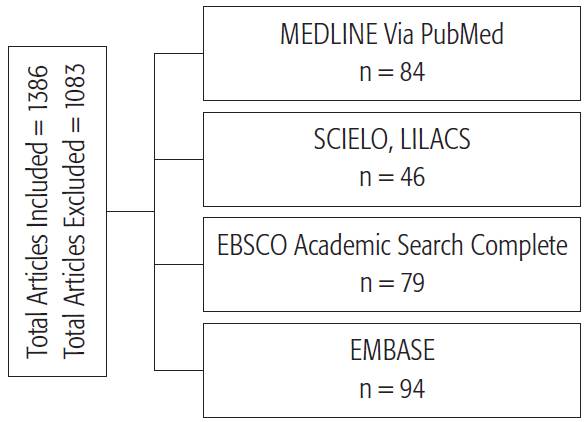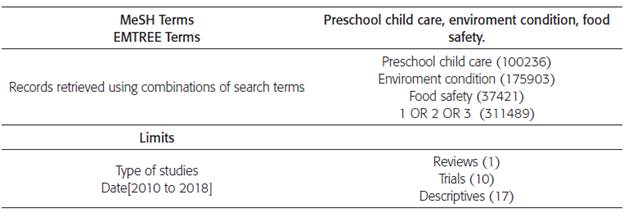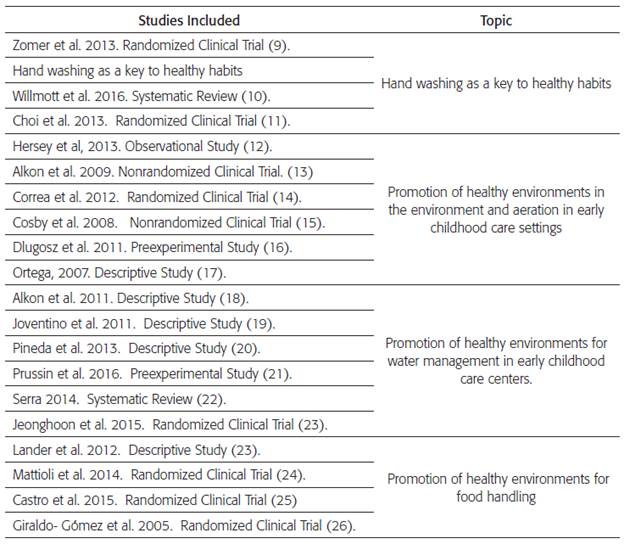INTRODUCTION
Within the framework of early childhood policies, the World Health Organization (WHO) recommends mobilizing strategies for the promotion of healthy environments and the health care of children in order to mitigate the more than three million deaths of children. under five years of age in the world due to causes associated with the environment 1. These strategies should be directed towards the characterization of environments susceptible to contamination particularly where food is handled (kitchens and dining rooms). Kitchens are considered as critical points where potentially pathogenic microorganisms can be introduced from the people who handle them, from food that is not safe from its preparation, obtaining or storage, or from contaminated water, posing a risk to the health of the consumers 2. Child care providers are expected to apply standardized hand washing and safe food handling procedures, such as those established by the WHO through the five-key manual for food safety 3,4.
Health care and the promotion of healthy environments in early childhood care places are considered relevant issues in Public Health worldwide. The objective of this article is to present a synthesis of the literature that allows the identification of the lines of action for the promotion of hygiene conditions and the safety of food as key issues for the health care of children.
METHOD
An interdisciplinary group of expert researchers was formed in the subject that allowed the development of a protocol to conduct a systematic narrative review based on the Egger and Smith methodology 5, which establishes seven phases:
Construction of a search question - PI-COT question (Population, Intervention, Comparison, Results and Study type)
Determination of inclusion criteria for article eligibility
Access and location of studies in databases
Selection of studies
Evaluation of the quality of the studies
Extraction and synthesis of relevant data
Potential analysis and presentation of results
1. Construction of the search PICOT question. The systematic literature review was conducted based on the PICOT question: What are the lines of action for the promotion of hygienic conditions and the safety of food for the health care of children?
From the components of the PICOT question, the search terms MeSH, Thesaurus All Fields and SubHeadings were obtained: Preschool child care, environment condition, food safety.
2. Criteria for the selection of articles. For inclusion in the sample, the following criteria were taken into account:
Controlled clinical trials, association studies and observational studies published in English, Portuguese or Spanish.
Studies carried out in places of attention in early childhood.
Studies analyzed as having high methodological quality following the revision procedure included in the SIGN Methodological Guide (Scottish Intercollegiate Network), which is part of the guidelines of the Ministry of Health and Social Protection of Colombia. Individually, the relevant findings of the analysis were recorded in the synthesis table proposed by Melnyk et al. 6
3. Search strategy and location of studies in databases. A bibliographic search was performed in different access databases of the National System of Libraries of the National University of Colombia and the University of La Salle. The main databases consulted were: Medline, Pubmed, Embase, LILACS, ScienceDirect, Web of Science, SciELO, Scopus and Redalyc, with a search window from 2010 to 2016. With the Analyze search results tool available in Scopus, the trend of the reports in terms of authors, institutional affiliation, country and area of knowledge
MeSH Terms EMTREE Terms
Records retrieved using combinations of search terms
4. Selection of studies. Studies that met the inclusion criteria were included in the search to document the environmental conditions of hygiene and food safety. Figure 1 shows the process of selecting and organizing the studies.

Source: Prepared by authors.
Figure 1 Process of selection and organization of articles included in the analysis
5. Evaluation of the quality of the studies. In the review protocol it was established that the most useful tool to consider the relevance of the studies was the one proposed by the CASP Program (Critical Appraisal Skills Program) which consists of the application of 38 questions as minimum criteria for the quality of the studies 7. By agreement in the group of experts, the studies that responded to a percentile of methodological quality greater than 80% obtained in the evaluation of quality checklists of the studies were included in the synthesis.
6. Extraction of the relevant data. The relevant study data were extracted with the SIGN tool 8 as reference.
7. Analysis and presentation of results. Once the evidence was synthesized, four lines of action were structured as an innovative result for the generation of future intervention proposals in the promotion of healthy habits in early childhood.
The ethical principles of the research were fulfilled, for which the UGI-221-2001 endorsement of the Ethics Committee of the Faculty of Nursing of the National University of Colombia was included, as part of the research project contract 363 financed by Colciencias, the National University of Colombia Bogota headquarters and the University of La Salle.
RESULTS
The results of the qualitative systematic review were synthesized in the table of evidence synthesis based on four lines of action identified as follows:
Lines of action:
Hand washing as a key to healthy habits;
Promotion of healthy environments in the environment and aeration in early childhood care settings;
Promotion of healthy environments for water management in early childhood care centers and;
Promotion of healthy environments for food handling.
Regarding the type of study, meta-analysis or systematic integrative studies were not found. The clinical trials that met the inclusion criteria were analyzed and included in the narrative discussion to argue each line of action constructed. It was not possible to present quantitative results due to the heterogeneity of the data and the different methodological approaches. Due to the quality of the studies found and the need to explore the topic in a comprehensive manner, descriptive observational studies were included.
With the tool Analyze search results available in Scopus, the tendency of increase of the reports was observed from the year 2011, this according to the growing need to carry out primary studies of educational intervention to improve health in early childhood. In the methodological critique of the studies, it was found that the intervention studies (clinical trials) did not control all the biases mainly with the random allocation of the participants and in the blinding of the intervention. In this way, observational studies, although their level of evidence is lower in the evaluation of methodological quality, obtained a better evaluation by the group of experts. Therefore, it was decided to perform a systematic narrative review in order to take advantage of the descriptive results from the primary studies that, when applying the checklists, obtained a percentile higher than 80% and that, according to experts, contributed to the construction of the presented synthesis.
DISCUSSION
The four lines of action structured based on the analysis of the results are useful to present the relevant evidence that can serve as a support for the promotion and care of health in early childhood. It is proposed that these lines of action be accepted as strategies for the implementation of educational and health promotion interventions in community and institutional settings not only in the research setting but also to direct nursing care in the first level of attention to health.
The line of action in hand washing; it is the first strategy to be linked in the promotion of healthy environments since it is the most cost-effective practice that children and their caregivers can apply to prevent the spread of diseases in early childhood care settings. The Zomer study in 36 child care centers showed that the educational intervention in hand washing is effective to improve compliance with the guidelines on hygiene and the reduction of up to 25% of gastrointestinal infections and 15% of respiratory diseases for the benefit of the children who attend care centers during a period of 8 months with respect to the control group 9. In contrast, the lack of knowledge and interest of caregivers, has become the main challenge and obstacle to overcome in the effective implementation of the universal technique of handwashing, so more educational interventions are required within the population and linking a greater number of participants. In the systematic review of Willmott et al, 18 studies were included, which could not be meta-analyzed due to the heterogeneity of the effect of the interventions. They report that the design and results of the studies were of low quality, which prevented the meta-analysis from being carried out. This review recommends controlling the risk of bias in future trials 10.
The results of individual studies suggest that interventions in hand washing protocols and healthy habits can reduce children's absenteeism, incidence and symptoms of respiratory infection. 10,11. All healthcare actors, professionals, caregivers and families, are expected to adhere to the hand-washing procedure routinely, as well as the people who are responsible for the preparation and handling of food in the care centers and schools. . Choi, in an evaluation to 64 educators about the adherence to the hand washing protocol found that the experimental group showed significantly higher scores after the test of knowledge and preventive behaviors than those of the control group t test (p <0.001) 12-14. That is why including hand washing in educational processes is the key to significantly reduce the prevalence of communicable diseases 15. Institutional strategies should be implemented for the provision of soap, disposable towels and / or antibacterial gel, as well as the adequate supply of water and the necessary infrastructure to facilitate the procedure, since the lack of inputs may mean an impediment to the realization of this procedure as evidenced in the study by Correa et al, who found hygiene deficiencies in 17% of the 34 institutions evaluated for lack of such inputs. Regression analysis showed that after the follow-up visit the intervention centers significantly improved their safety and hygiene practices in emergency preparedness and handwashing compared to the control group centers 16,17. In summary, although the habit of handwashing is the key strategy for children's health due to its cost-effectiveness compared to the high cost of care for preventable infectious diseases, it is necessary to conduct a greater number of intervention studies with high methodological rigor to demonstrate the effect of the benefit of such interventions.
Promotion of healthy environments in the environment and aeration in early childhood care settings; it is constituted in a line of contribution for the control of the microorganisms that are in the surfaces and that alter the safety of the foods, is necessary that the team that work in the places of attention in early childhood fulfill adequate procedures of cleaning and disinfection, using a chemical agent such as sodium hypochlorite, as in the Alkon study, in which cleaning and disinfection policies were implemented in 38 childcare schools where an increase in compliance standards was shown based on these policies 18 ; however, it is necessary to take into account the concentration and the minimum time of action recommended to achieve the desired objective, as well as to clean the surfaces of organic waste first, to achieve a good disinfection 19. It has been reported that the use of hypochlorite to wash the household reduces the presence of E. coli and S. enteriditis in sponges up to the limit of non-detection at 24 hours 12,13. The cleaning and disinfection of elements and the environment is recommended in all the guides, as well as the continuous ventilation of the floors and tables routinely 20-22.
Another strategy is to comply with national and international infrastructure guidelines of child care centers, since lack of ventilation and infrastructure problems in homes represent a risk for the transmission of pathogens. Therefore, adequate air flow, as well as temperature, humidity and air speed in child care centers, can reduce the risk of bacterial structure formation 23-25.
Promotion of healthy environments for water management in early childhood care settings; The isolation of Gram-negative bacteria, parasites and fecal coliforms is the main indicator of water contamination, being the surfaces of the bathroom and the kitchen the main places of contamination by these bacteria. Additionally, the counting of faecal coliforms on surfaces in contact with hands inside homes indicates a potential risk of dispersion of faecal pathogens 25,26. Studies conducted by Tedesco et al, show that water is the main means of transmitting intestinal parasites; however, these studies do not consider intervention elements in the community, which should be determinant in controlling the presence of these contaminants in the water. 27-29.
Finally, continuing education based on communication with direct caregivers about the proper management of water has shown positive results in reducing diarrheal diseases caused by contaminated water consumption 30-34.
Promotion of healthy environments for food handling; this line of action refers to the conditions for the maintenance of food safety, specifically in kitchens and surfaces that are in contact with hands and food consumed by children.
The quality of food is a determinant for children's health, because by their physical and chemical characteristics foods have the ideal conditions for the growth of microorganisms that can alter their quality and therefore their harmlessness, either from any link of the production chain or through those who manipulate them 35-43.
The manipulators are the main responsible for the prevention and control of food contamination, contributing to food safety, with the responsibility of ensuring that their health status, personal hygiene and the processes they perform are appropriate, as well as the use of protective clothing, head covering, mask and appropriate footwear, washing their hands according to the protocol of hand washing and at the indicated times 44. Caregivers and people who have direct contact with food and food preparation areas still lack knowledge and safe practices about universal measures for the proper handling of food and utensils. 45-47
In short, programs of direct educational intervention with caregivers and people who handle food, through awareness and positive reinforcement of cleaning and disinfection routines, should be continuous strategies to strengthen healthy habits, knowledge and routine safe practices. in the decrease of the proportion of microorganisms present in the food preparation sites and in the food and in this way guaranteeing the health care of the children 48-50.
CONCLUSIONS
The lines of action described above constitute a novel contribution for health professionals who wish to implement proposals for a comprehensive approach in the promotion of healthy habits in early childhood care settings.
Health education as a continuous and structured process can positively influence the decrease of communicable diseases in care centers, mainly in gastrointestinal diseases caused by transmitted bacteria and parasites, commonly by contaminated water. In addition, the active participation of caregivers and parents, in an effort of inclusion and teamwork, can be useful for good habits, not only in care centers, but in the homes of children.
Sensitization and inclusion interventions are required of the people who handle the food, educating about the accomplishment of cleaning routines, disinfection as well as compliance with standard protection measures (hat, gloves, masks) and adherence to the universal hand washing protocol.
It is recommended to advance in the performance of controlled clinical trials of high methodological quality that perform a systematic control of biases and with large samples that represent a greater scientific evidence to show the impact and safety of intervening in the four lines of action described above, since the lack of studies with these characteristics limits the performance of systematic quantitative reviews and meta-analysis.
















